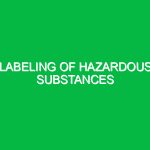Introduction
Understanding Material Safety Data Sheets (MSDS) is crucial for anyone involved in health, safety, and environmental protection. An MSDS is a detailed document that provides information about a specific substance, including its properties, hazards, handling instructions, and emergency measures. These sheets not only empower workers with essential safety knowledge but also play a vital role in compliance with regulations. In this comprehensive guide, we will explore the purpose of MSDS, delve into potential hazards, outline best practices for safety, and review the regulatory framework that governs these important documents.
The Importance of MSDS in HSE
MSDS are foundational tools in the HSE domain, designed to ensure that workers are informed about the substances they encounter. The information contained in an MSDS helps prevent accidents and injuries, promoting a culture of safety within organizations. For instance, during my time working in a chemical plant, we relied heavily on MSDS to train new employees on the risks associated with various chemicals, such as solvents and acids. Each MSDS became a vital part of our onboarding process, ensuring that everyone understood not only the hazards but also the steps to mitigate them.
Potential Hazards and Risks Associated with MSDS
Understanding Material Safety Data Sheets (MSDS) involves recognizing the potential hazards associated with the substances listed within them. These hazards can be categorized into various types, including:
Chemical Hazards
Chemical hazards are among the most significant risks. Substances may be toxic, corrosive, flammable, or reactive. For example, sulfuric acid, a common industrial chemical, can cause severe burns upon contact with skin. An MSDS for sulfuric acid would detail its hazards, providing information on the necessary personal protective equipment (PPE) to wear when handling it.
Physical Hazards
Physical hazards include risks related to the physical properties of substances, such as their flammability or reactivity. For instance, a flammable liquid like gasoline poses an explosion risk if not stored properly. The MSDS would highlight the importance of keeping it away from heat sources and using proper storage containers.
Health Hazards
Health hazards refer to the potential for substances to cause health issues, either through immediate effects or long-term exposure. For instance, asbestos is a well-known carcinogen that can lead to serious respiratory issues when inhaled. An MSDS for asbestos would not only indicate its presence but also outline safe handling and disposal procedures.
Environmental Hazards
Some substances can pose risks to the environment, such as pollution of water sources or harm to wildlife. For example, certain pesticides can accumulate in ecosystems, affecting various species. MSDS documents are crucial in detailing these risks and providing guidance on spill response and environmental protection measures.
Detailed Safety Precautions and Best Practices
Once the hazards are understood, implementing safety precautions becomes paramount. Here are several detailed safety measures and best practices related to MSDS:
Personal Protective Equipment (PPE)
Wearing appropriate PPE is often the first line of defense against potential hazards. An MSDS will specify the required PPE based on the substance’s risks. For example, when handling corrosive materials, it’s essential to wear chemical-resistant gloves, goggles, and face shields. Ensuring that all employees are trained on how to use and maintain PPE can significantly reduce the risk of injury.
Proper Storage and Labeling
Storing hazardous materials correctly is critical to preventing accidents. MSDS documents provide guidance on safe storage practices. For instance, flammable liquids should be stored in explosion-proof cabinets, while incompatible substances should be kept apart to prevent dangerous reactions. Effective labeling is equally important; each container should have a clear label indicating its contents and associated hazards.
Emergency Response Planning
An effective emergency response plan is essential for any workplace handling hazardous materials. MSDS documents typically include information on what to do in case of spills, leaks, or exposure incidents. For example, if a toxic chemical spills, the MSDS will outline the steps for containment, cleanup, and evacuation procedures. Regular drills and training sessions can ensure that employees are prepared for emergencies.
Training and Awareness
Regular training sessions help reinforce the importance of MSDS and ensure that employees are familiar with the hazards they may encounter. For instance, during my tenure at a manufacturing facility, we held quarterly training sessions where we reviewed various MSDS documents. This approach not only kept safety at the forefront but also encouraged open discussions about safety concerns among staff.
Regulatory Standards Governing MSDS
Understanding the regulatory framework surrounding Material Safety Data Sheets (MSDS) is essential for compliance and safety in the workplace. In many countries, regulations dictate the format and required content of MSDS. Here are some key regulations:
Occupational Safety and Health Administration (OSHA)
In the United States, OSHA mandates employers to maintain and provide access to MSDS for hazardous chemicals in the workplace. The OSHA Hazard Communication Standard (HCS) requires that MSDS include specific sections, such as hazard identification, first-aid measures, and handling and storage instructions. This ensures that employees have access to vital safety information.
Globally Harmonized System (GHS)
The Globally Harmonized System of Classification and Labelling of Chemicals (GHS) is an international guideline that harmonizes the classification and labeling of chemicals. GHS-compliant MSDS are structured in a specific format, making it easier for workers globally to understand the risks associated with chemicals. This system is increasingly being adopted worldwide, improving safety in various industries.
Environmental Protection Agency (EPA)
The EPA regulates hazardous substances and requires that certain chemicals be reported to prevent environmental contamination. MSDS documents play a crucial role in ensuring compliance with these regulations by providing information on disposal methods and environmental hazards associated with specific substances.
Conclusion
Understanding Material Safety Data Sheets (MSDS) is not merely an administrative task; it is a vital component of health, safety, and environmental management. By recognizing the potential hazards associated with various substances, implementing best practices, and adhering to regulatory standards, organizations can create safer workplaces for employees and protect the environment. Remember, the ultimate goal of an MSDS is to inform and empower individuals to make safe choices regarding hazardous materials. As we navigate the complexities of modern industry, let us prioritize safety through knowledge and awareness, ensuring that all employees return home safely each day.


